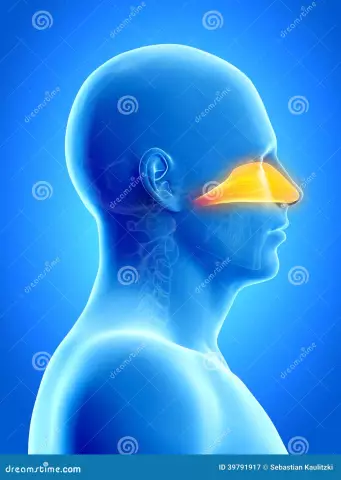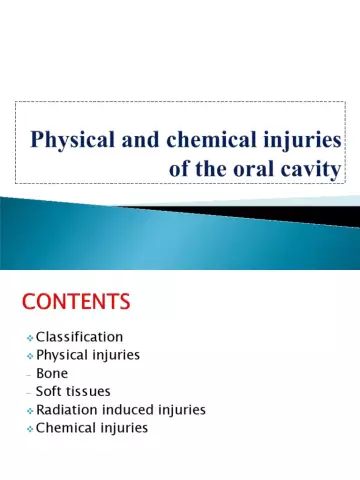- Author Rachel Wainwright [email protected].
- Public 2023-12-15 07:39.
- Last modified 2025-11-02 20:14.
Nasal cavity
Brief description of the nasal cavity

The nasal cavity is the cavity that is the beginning of the human respiratory tract. It is an air channel that communicates in front with the external environment (through the openings of the nose), and behind - with the nasopharynx. The organs of smell are located in the nasal cavity, and the main functions are to warm, cleanse from foreign particles and moisturize the incoming air.
The structure of the nasal cavity
The walls of the nasal cavity are formed by the bones of the skull: ethmoid, frontal, lacrimal, wedge-shaped, nasal, palatine and maxillary. The nasal cavity from the oral cavity is delimited by a hard and soft palate.
The external nose is the anterior part of the nasal cavity, and paired openings in the back connect it to the pharyngeal cavity.
The nasal cavity is divided into two halves, each of which has five walls: lower, upper, medial, lateral and posterior. The halves of the cavity are not entirely symmetrical, since the septum between them, as a rule, is slightly deviated to the side.
The most complex structure is at the lateral wall. Three turbinates hang inward on it. These conchas serve to separate the upper, middle and lower nasal passages from each other.
In addition to bone tissue, the structure of the nasal cavity includes cartilaginous and membranous parts, which are distinguished by mobility.
The vestibule of the nasal cavity is lined from the inside with a flat epithelium, which is a continuation of the skin. In the connective tissue layer under the epithelium are the roots of bristle hair and sebaceous glands.
The blood supply to the nasal cavity is provided by the anterior and posterior ethmoid and cuneiform-palatine artery, and the outflow is provided by the cuneiform-palatine vein.
The outflow of lymph from the nasal cavity is carried out into the chin and submandibular lymph nodes.
The structure of the nasal cavity is distinguished:
- The upper nasal passage, located only in the posterior part of the nasal cavity. Typically, it is half the average travel. The posterior cells of the ethmoid bone are open into it;
- The middle nasal passage, located between the middle and lower shells. Through the canal in the form of a funnel, the middle nasal passage communicates with the anterior cells of the ethmoid bone and the frontal sinus. This anatomical connection explains the transition of the inflammatory process to the frontal sinus with a cold (frontal sinus);
- The inferior nasal passage runs between the bottom of the nasal cavity and the inferior concha. It communicates with the orbit through the nasolacrimal duct, which ensures the flow of tear fluid into the nasal cavity. Due to this structure, nasal discharge intensifies when crying and, conversely, quite often "watery" eyes with a cold.
Features of the structure of the nasal mucosa
The nasal mucosa can be divided into two areas:
- The superior turbinates, as well as the upper part of the middle turbinates and nasal septa, are occupied by the olfactory region. This area is lined with pseudo-stratified epithelium containing neurosensory bipolar cells responsible for smelling;
- The rest of the nasal mucosa is occupied by the respiratory region. It is also lined with pseudostratified epithelium, but it contains goblet cells. These cells secrete mucus, which is essential for moisturizing the air.
Regardless of the region, the lamina of the nasal mucosa is relatively thin and contains glands (serous and mucous membranes) and a large number of elastic fibers.
The submucosa of the nasal cavity is thin enough and contains:
- Lymphoid tissue;
- Nerve and vascular plexuses;
- Glands;
- Mast cells.
The muscle plate of the nasal mucosa is poorly developed.
Functions of the nasal cavity

The main functions of the nasal cavity include:
- Respiratory. The air inhaled through the nasal cavity makes an arched path, during which it is cleansed, warmed and moisturized. Numerous blood vessels and thin-walled veins located in the nasal cavity contribute to warming the inhaled air. In addition, air inhaled through the nose exerts pressure on the nasal mucosa, which leads to arousal of the respiratory reflex and a greater expansion of the chest than when inhaling through the mouth. Violation of nasal breathing, as a rule, affects the physical condition of the whole organism;
- Olfactory. The perception of odors is due to the olfactory epithelium, located in the epithelial tissue of the nasal cavity;
- Protective. Sneezing, which occurs when the end of the trigeminal nerve is irritated by coarse suspended particles in the air, provides protection against such particles. Lacrimation helps to cleanse when inhaling harmful air impurities. In this case, the tear flows not only outside, but also into the nasal cavity through the nasolacrimal canal;
- Resonator. The nasal cavity with the oral cavity, pharynx and paranasal sinuses serve as a resonator for the voice.
Found a mistake in the text? Select it and press Ctrl + Enter.






